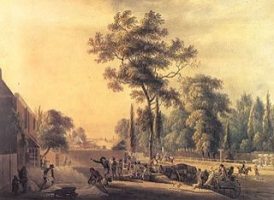
This fourth painting in my series examines the work of the 'Father of English watercolour painting'. Hope you enjoy it. http://www.handprint.com/HP/WCL/artist02.html
View on the Road Near Bayswater Turnpike by Paul Sandby 1730 - 1809
Any examination English watercolour painting would be incomplete if it did not include a section about Paul Sandby 1730- 1809. He is affectionately known as 'The father of English Water colour painting'. Along with his brother Thomas, He gave the impertus to what were topographical sketches initially, drawn with a great deal of draughtsmanlike precision, into the embryo of English landscape painitng.
His very stylised treatment of landscape became a bastion to many that followed but it was a somewhat flat if accurate drawing style that eminated from his talent as a gifted mapmaker.
He was borne in Nottingham in or around 1730 and along with his brother Thomas, also influential on the landscape art of the period, was a founder member of the Royal Acadamy 1768.
In the early 1740's he joined the Board of ordinance at the Tower of London and was given the task of mapping the remote Scottish Highlands in 1746.
During this period he developed his typical style of landscape painting.
His brother Thomas became Warden to Windsor great Park and Paul was invited to join him in 1752 to produce a series of watercolours and drawings of the Royal estate at Windsor. Later on he visited Wales and produced a series of drawings depicting Welsh landscapes.
In 1768 he was appointed to the position of chief drawing master to the Royal Acadamy and held that position until 1799. Tenyears later he died in London.
If you look at the painting closely you will see the influence of his architecural draughtsman style. particularly in the buildings on the left of the painting.
Note the draughtsmanlike dealing with perspective in the building and the strict adherence to straight line direction to the vanishing point at or around the slight summit of the road in the distance. Such accuracy was typical of both Sandby brothers.
I looked at the picture for the first time and found the golden section not immediately obvious. but a second look gave me the chance to see a device often used by Sandby to highlight the accuracy of his Architecture. That of the 'standing figure'
The golden section of this drawing moves from centre ground in the guise of the trunkof the tall tree and developes horizontally left under the feet of the group of figures centre left of the painting. centrally to that gruop is the atypical Sandby figure pointing to the buildings to the left. It is a clever device of Sandby that he uses the p[ointing fure to direct the eye to the simple perspective accuracy of the buildings. The hihglighting of that perspective to the observer adds depth in my veiw to what would otherwise be a flat painting.
So central and imposing is that standing figure that it detracts from a much more interesting activity going on to the right of the tree and relagates the loading and unloading of the cart to a mere incidental.
The fact of the matter is that neither of the Sandbys were good figure artists.Paul was the better of the two and often added figures to the landscapes of his brother because Thomas was not a master figurist.
Critique of Paul's figures centre on the tendency for him to 'elongate' the bodies of his figures. The central figure in this picture demonstrates that admirably.
Both Thomas and Paul used a limited pallet, chiefly of ochres and browns with the occasional spot of red., and that is one of their trademarks.
The other typical clue to their vwork is the use of the pen after and on top of water colour washes.
This is no more prevalent than in their treatment of foliage.
Look at the tree. Take a close look at the leaves. Whispy autumnal colours but in a high summer setting.
This effect was produced by tightly washing in colour in dabs to denote blocks of foliage, thgen producing the leaves with a draught pen and ink in a series of tight loops. it is a style adopted by water colour artists for the next 30 years and is an unmistakeable device as to the period of early English water colour.
Enjoy Paul Sandby. If you want to buy one of his painitngs I think you would be surprised at how reasonable his paintings are priced. The average price last in 2006 for a watercolour by him at auction in uk was £1900.
Some years ago I bought a painting of his for £ 68 at a car boot sale , didnt recognise it for what it was and sold it for £120. I was perfectly content until the guy I sold it to went on to sell it at auction for £1200.
The lesson , never buy art as an investment buy it because you like it.
Enjoy Sandby at your leisure please.
In this case
Poetry by lastromantichero
Read 1065 times
Written on 2007-08-04 at 09:57

|
Kathy Lockhart |

|
kath |
| Texts |
